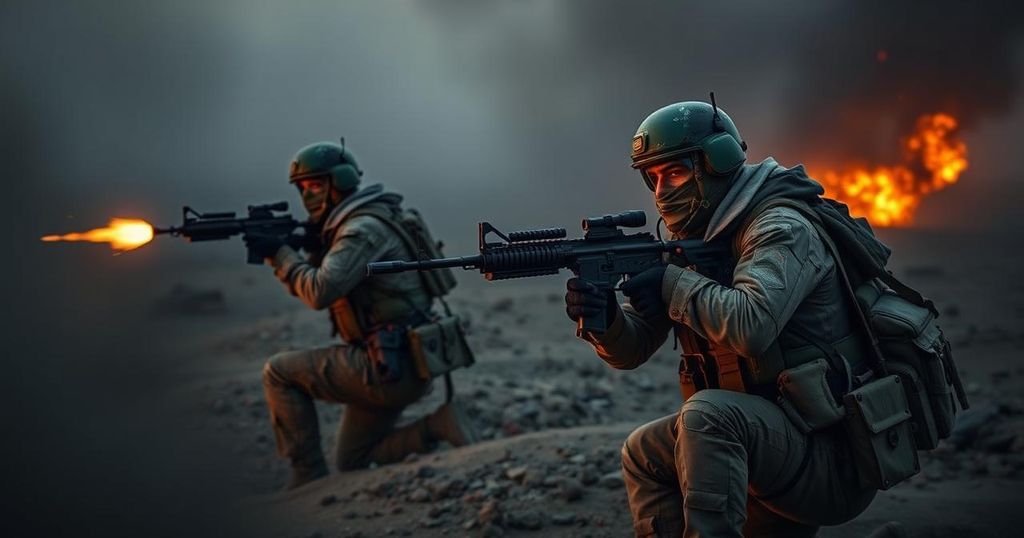Escalation of Attacks by Iran-Linked Militias in Iraq: Implications for Israel and Regional Stability

Iran-affiliated militias in Iraq have escalated their attacks on Israel, launching approximately 40 strikes in over two weeks amid tensions following the death of Hezbollah’s leader. This increase follows months of conflict in Gaza and reflects Iran’s strategy to utilize a network of regional proxies. Despite significant Israeli military responses, the situation remains fraught with volatility, underscoring the importance of these developments in the broader Middle Eastern conflict landscape.
In recent weeks, Iran-affiliated militias in Iraq have dramatically intensified their attacks against Israel, launching approximately 40 missile, drone, and rocket strikes in a span of just over two weeks. This surge in aggression marks a significant escalation in the proxy conflict unfolding across the Middle East, which has been largely concealed from public view. The hostilities commenced in October of the previous year, coinciding with the outbreak of war in Gaza, yet they have accelerated following the Israeli airstrike that killed Hezbollah’s leader, Hassan Nasrallah, on September 27. Hezbollah, established with Iranian backing more than four decades ago, serves as the cornerstone of Iran’s coalition of regional militia groups. With Hamas considerably diminished after enduring a prolonged conflict in Gaza and Hezbollah currently facing persistent Israeli military operations in Lebanon, Iran is turning to less prominent factions within its network to mount assaults against its principal adversary. Michael Knights, an analyst at the Washington Institute, has observed that “the number of missiles and drones being fired from Iraq [at Israel] has gone through the roof,” indicating a concerted effort by these militias to manifest their solidarity with Hezbollah. The missiles launched by these groups underscore Iran’s broader strategy of leveraging its network of allied factions to support one another in their confrontations with Israel, while also fostering competition among these groups to display their capability and allegiance. In light of recent provocations, analysts point to the proxy forces engaged in Syria, Iraq, and Yemen as potential targets for Israeli countermeasures. Following Iran’s large-scale missile launch targeting Israel on October 1, 2023, Israel has augmented its military operations. Previously, Israeli forces have conducted numerous airstrikes in Syria, targeting sites linked to Iran to safeguard crucial supply routes facilitating arms transportation to Hezbollah. A notable Israeli operation last month involved a raid on a suspected Iranian weapons facility in Syria’s Masyaf region, resulting in the destruction of critical equipment and the acquisition of vital documentation. The escalation of hostilities has prompted Israeli military action against both Iranian-backed factions in Syria and Iraq, with recent reports noting the successful targeting of high-ranking officials affiliated with the Islamic Resistance of Iraq (IRI). Notably, the ongoing struggles among these factions have resulted in significant casualties. For instance, a direct Israeli strike on pivotal targets in Yemen recently resulted in 62 civilian casualties, exemplifying the far-reaching implications of the conflict. Despite receiving limited media attention, experts underscore the importance of these engagements. Michael Knights remarked, “Every big war has its forgotten corners,” highlighting the concealed but crucial dynamics at play in the Middle Eastern conflicts. Overall, the current trend indicates that Iran’s strategy and the subsequent responses by its adversaries might significantly influence the regional balance of power in the coming weeks and months.
The article addresses the recent surge of attacks by Iran-backed militias in Iraq targeting Israel. It contextualizes these military actions within the broader proxy conflict in the Middle East, emphasizing the role of Iran in supporting various militant groups. The timeline of events illustrates how the escalation followed the death of Hezbollah’s leader and highlights the weakened status of both Hamas and Hezbollah in the current conflicts. It also discusses Israel’s military responses to these provocations, emphasizing the interconnected nature of these regional conflicts that have largely gone unnoticed in mainstream discourse.
In summary, Iran-supported militias in Iraq have exponentially increased their missile and drone assaults on Israel amidst escalating tensions in the Middle East. This uptick in hostilities, following the death of Hezbollah’s leader and the weakened status of militant groups like Hamas and Hezbollah, reflects Iran’s strategy to deploy a range of proxies to confront its enemies. The situation remains precarious, with Israeli forces actively engaging these proxies, further complicating the regional power dynamics while drawing attention to the oft-overlooked theaters of conflict. Experts recognize that these confrontations are pivotal in understanding the broader implications for stability in the Middle East.
Original Source: www.theguardian.com








